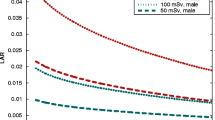Abstract
Objective
The aim of this study was to estimate radiation exposure and evaluate the risks and benefits of 18F-fluorodeoxyglucose positron emission tomography (FDG-PET) in cancer screening.
Methods
A nationwide survey of FDG-PET cancer screening was conducted in 2006, and the results were analyzed with a common index, “extension/shortening of the average life expectancy.”
Results
The average estimated effective dose was 4.4 mSv (male 4.7 mSv; female 4.0 mSv) for dedicated PET and 13.5 mSv (male 14.2 mSv; female 12.8 mSv) for PET/computed tomography (CT). The risk–benefit break-even age from the viewpoint of radiation exposure was in the 40s for men and 30s for women for dedicated PET and in the 50s for men and 50s (variable injection dose) or 60s (constant injection dose) for women for PET/CT.
Conclusions
FDG-PET cancer screening is beneficial for examinees above the break-even ages. The risks and benefits should be explained to examinees because of the larger radiation used in cancer FDG-PET screening compared with other X-ray tests.

Similar content being viewed by others
References
Iinuma T, Tateno Y, Hashizume T, Umegaki Y, Kitabatake T. Benefit-risk analysis for mass screening of stomach cancer in Japan. 1. Life-saving vs. loss of life. Nippon Igaku Houshasen Gakkai Zasshi. 1977;37:1109–21.
Iinuma T, Tateno Y. Risk–benefit analysis for mass screening of breast cancer utilizing mammography as a screening test. Nippon Igaku Houshasen Gakkai Zasshi. 1989;49:1091–5.
Iinuma T, Tateno Y. Benefit-risk analysis of mass screening for lung cancer. Nippon Igaku Houshasen Gakkai Zasshi. 1990;50:101–6.
Murano T, Iinuma T, Tateno Y, Daisaki H, Tateishi U, Terauchi T, et al. Risk–benefit analysis of 18FDG-PET cancer screening. Nippon Houshasen Gijutsu Gakkai Zasshi. 2008;64:1151–6.
Japanese Society of Nuclear Medicine. The guideline of FDG-PET cancer screening. Kaku Igaku. 2007;44:1–28.
International Commission on Radiological Protection. Radiation dose to patients from radiopharmaceuticals, ICRP Publication 80, Addendum to ICRP 53, J Valentine. Oxford: Pergamon Press; 1998.
Jones D, Shrimpton P. NRPB-SR250: Normalised organ doses for x-ray computed tomography calculated using monte carlo techniques. National Radiological Protection Board; 1993.
ImPACT. CT patient dosimetry Excel spreadsheet (version 0.99v, 17 June 2004). http://www.impactscan.org/.
International Commission on Radiological Protection. Referenceman: anatomical physiological and metabolic characteristics. ICRP Publication 23, J Valentine. Oxford: Pergamon Press; 1975.
1990 Recommendation of the International Commission on Radiological Protection (ICRP Publication 60). Ann Icrp, vol 21. Oxford: Pergamon; 1991. p. 1–201.
The 20th Life Tables For Japan 2005. Statistics and Information Department Minister’s Secretariat Ministry of Health, 2007.
Cancer Statistics in Japan 2007. The Editorial of the Cancer Statistics in Japan; 2007.
Pierce D, Shimizu Y, Preston D, Vaeth M, Mabuchi K. Studies of the mortality of atomic bomb survivors. Report 12, Part 1. Cancer. 1950–1990. Radiat Res. 1996;146:1–27.
Minamimoto R, Senda M, Uno K, Jinnouchi S, Iinuma T, Ito K, et al. Performance profile of FDG-PET and PET/CT for cancer screening on the basis of a Japanese Nationwide Survey. Ann Nucl Med. 2007;21:481–98.
Okamoto N, Saruki N, Mikami H, Yamashita K, Maruyama Y, Yano T, et al. 5-year survival rates for primary cancer sites at cancer-treatment-oriented hospitals in Japan. Asian Pacif J Cancer Prev. 2006;7:46–50.
Saruki N. 16-2 Chiiki gan-senmon-shinryou-shisetsu no sofuto-men no seibi-kakusyuu ni kansuru kenkyuu. A 2006 report of Grant-in-Aid for Cancer Research from the Ministry of Health, Labor, and Welfare, Japan. 2006; p. 21–34.http://www.gunma-cc.jp/sarukihan/seizonritu/index.html/.
Daisaki H, Suzuki K, Fukukita H, Fukushima H, Satou T, Shinohara H. Influence of count rate on image quality in three-dimensional PET acquisition. Nippon Houshasen Gijutsu Gakkai Zasshi. 2008;64(4):407–16.
Terauchi T, Murano T, Daisaki H, Kanou D, Shoda H, Kakinuma R, et al. Evaluation of whole-body cancer screening using 18F-2-deoxy-fluoro-d-glucose positron emission tomography: a preliminary report. Ann Nucl Med. 2008;22(5):379–85.
Ide M. Cancer screening with FDG-PET. Q J Nucl Med Mol Imaging. 2006;50(1):23–7.
Acknowledgments
This research was supported by a Grant-in-Aid for Cancer Research from the Ministry of Health, Labor, and Welfare, Japan. The authors thank Sachiko Yanagida and Yoshihide Nakamura of the Japan Radioisotope Association for their cooperation in the field investigation.
Author information
Authors and Affiliations
Corresponding author
Additional information
This article was previously published in Kakuigaku in Japanese (48[1]:1–13.2011). We obtained permission from the editorial office to republish this article in English.
Rights and permissions
About this article
Cite this article
Murano, T., Minamimoto, R., Senda, M. et al. Radiation exposure and risk–benefit analysis in cancer screening using FDG-PET: results of a Japanese nationwide survey. Ann Nucl Med 25, 657–666 (2011). https://doi.org/10.1007/s12149-011-0511-1
Received:
Accepted:
Published:
Issue Date:
DOI: https://doi.org/10.1007/s12149-011-0511-1




